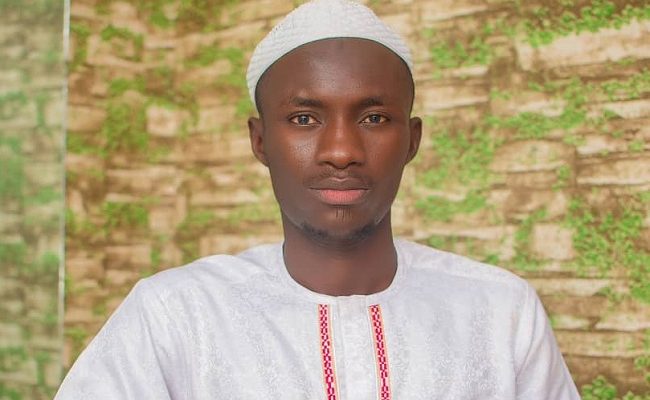
Samad Akorede, an entrepreneur specialises in the promotion of traditional African leather known as ‘ISONA’. In this interview with IFEDAYO OGUNYEMI, he spoke extensively about ISONA and how mentoring young individuals at the community level in the area of leadership can help them become responsible citizens.
Why is it important to preserve and promote traditional leather crafting techniques in today’s fast-paced, modern world?

Yes, it is important to preserve and promote traditional crafting in the modern world because these are the artifacts that should not be allowed to go into extinction, as a popular historian said and I quote: “He, who fails to know nothing about when he was born, will remain a child forever.”
Traditional crafting instills a sense of belonging to us; it makes us get involved in African history which has always been criticised that it doesn’t possess anything apart from European colonisation. Traditional crafting would surely tell another story, signaling to the Europeans that Africans were indeed civilised before their domination.
Many people in Africa have also lost touch with their heritage, and they tend to believe that their forefathers and mothers never used adornments. Meanwhile, all these adornments are what we have in abundance. It’s even our innovative ideas that birthed some of the things they see with the Europeans. In the same manner, I am not trying to condemn Europeans or their style of leather works, but I am willing to stand tall with my position that African traditional crafting is more unique.
It is pertinent to also state that Africans themselves have forgotten what they possess and this has pushed negativity into their crafting or designs. We have our interior styles of decorations, however; it is so sad that everything has been forgotten.
You have a background in statistics and research, but you’re now a major in the field of traditional leather crafting. Why the switch and in what ways do they complement each other?
I studied statistics because I love to calculate. Leather crafting is an innate skill I possess and at the same time hold in high regard. It’s important to let people know that leather crafting is our generational gift—most of us in our family have this skill because it was transferred from one possessor to the other. My father, when he was alive, was a great artist among his peers. He designed, drew many artifacts and transferred the drawing skills into his crafting. Learning from my dad was very simple; I was always sitting with him checking his art of crafting. Indirectly, the crafting was passed onto me at a very young age.
When I became a man who had to live on what was earned, I got to know I had to turn crafting into money. So, I went to meet an uncle of mine, told him I needed to work. Then, he took me in and he allowed me into the family shop. That was how I started expanding my knowledge about ancient crafting. Truth be told, I cannot say the love of money pushed me into leather work, but still, it has helped and also become the sole symbol of hope for me to have an institutional education like my friends.
You started off as an apprentice and now you’re a recognised entrepreneur. What challenges did you face in bringing traditional leather crafting to the mainstream market?
The challenges I faced in trying to bring the traditional part of crafting into leather work were numerous. To be sincere with myself, traditional crafting catapulted me into a whole lot of intricacy, assuming I am into European style of making leathers, shoes and bags, it will be so easy for me. The traditional crafting I am putting onto leather gave me one of the toughest challenges.
Sometimes in 2022, whenever I showed people my crafting, they were always downplaying the beauty of the crafting itself, saying, “It’s old-fashioned, people don’t use this anymore,” this was the statement many of them used to make.
While in tertiary institution, I used to make tote bags with visible crafting on it, many of my colleagues would say “I don’t like this design on bags, stop doing it; it’s spoiling the beauty of the bag.” 70 percent of Nigerians prefer European leather works to the ones made by Africans or Nigerians. Nigerians do not want to understand the concept of culture; we are perpetually concerned about the philosophy of European ideas, and thereby, making it a tedious job to promote our leather and crafting industry.
When I noticed this in 2022, I then changed my target audience. I moved on to show the ancient craft to people who appreciate it. The challenges I have faced so far in the industry are: convincing my colleagues and those who know nothing about crafts or African values.
As someone deeply involved in the preservation of ancient crafting techniques through ‘Isona,’ how do you see the role of traditional craftsmanship in contemporary Nigerian culture?
Culture in Africa walks in extension due to the nearness of regions to each other. Even in the primitive days or basically in the ancient days, crafts from North Africa (the Berbers) were exchanged hugely during the trans-Sahara trade. Many cultures and traditions were enormously exchanged, as the people in Northern Nigeria had close contact with the Berber. This led to the utilization of horses, donkeys and camels as means of transportation.
The documentation of West African culture by North African scholars—Ibn Batuta, and others led to the recognition of a library in Timbuktu. In some other ways, Nigerians have also had the opportunity to export their culture and traditions to people in West Africa—Benin Republic, Togo, Ghana, and others.
What unique elements of ‘Isona’ have you incorporated into your leatherwork, and how do they distinguish your creations from modern shoemaking methods?
Naturally, ‘Isona’ is unique, starting from the tanning of leathers. All other leather users get their materials from tanning companies i.e. companies that make leathers. But I can boast of tanning. Most of the leathers I use are always tanned by me. This is one of the uniqueness ‘Isona’ aptly possesses.
The second thing is, ‘Isona’ is an ancient crafting I am only trying my efforts in bringing this ilk of crafting into modern-day fashion. When you look at my type of crafting, two things would always come to your mind averagely: ancient and modern world.
Let me say this, the unique style I am using now is a distinctive way of stitching and we have different types of stitching – saddle stitching and machine stitching. Both stitchings have one common feature and that is thread and needle.
But, currently, I have made an innovation, which is, using leather to stitch leather. This type of stitching is what I have not seen anywhere. It is a method from our ancient crafting, which is called ‘ese ekute’ (the footsteps of a mouse). We use this type of crafting for designing leathers; I had to change it to stitching in order to allow my crafting unique in the leather industry. This mode of stitching is my superhero in the market. There is no replica for it. Ninety percent of people that see a bag with ‘ese-ekute’ type of stitching wish to own one.
Given your mentorship role in your community, how do you encourage young people to embrace traditional crafts while also exploring entrepreneurial opportunities?
Putting it out boldly, traditional crafting is indisputably unique; it is functionally durable and also beautiful. Anything traditional will always be different; they possess different looks and special uniqueness. Traditional crafting calls people to the table, especially people who value the culture. Going back to traditional crafting is very good, as it gives room for young entrepreneurs to boast of the knowledge of their lineage.
As a former Student Union leader and current mentor, how do you view the role of leadership in fostering social responsibility among young people in your community?
People were interested in my style of leadership during the days of my unionism; there were high expectations of me, and I thank God I came out fine. My activities in the union birthed a landmark for the students of the school, especially in the healthcare sector of the school.
Currently, I am instilling a different wave of leadership into the young ones in my community. I have perpetually demonstrated to them that a leader is different from a boss. As a leader, you have to do it first. When you tell the young ones that cybercrime is not good, you have to show them practical examples of how to make money without engaging in fraud. This is the path I have been putting them on. Once they can survive, people would value them and they will make their income in a formal way.
Looking ahead, what is your vision for the future of traditional leather crafting, and how do you plan to continue bridging the gap between ancient practices and modern entrepreneurship?
My vision for the future of traditional leather crafting is to encourage people of African descent to engage more with people like me in the industry, this will boost their morale to know they have something to fall back on. The plan is to pay attention to detail in your ancient crafting. Everything in this life works with details. If you want your works to be more presentable, you have to think outside the box. Every craft is beautiful when it is detailed; your crafting has to possess proper finishing touches. These touches will complement what you have put in your crafting. For ancient crafting to blend with the modern one, detailing has to be involved.
READ ALSO: Five times Tinubu’s govt has promised to kickstart Port Harcourt refinery








